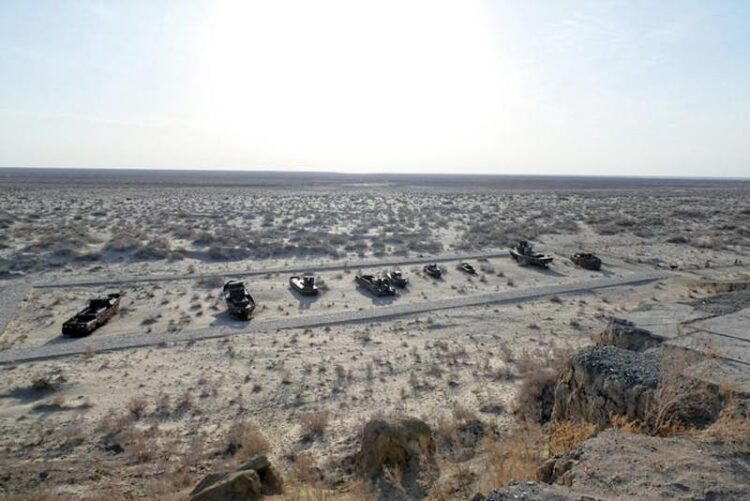Second Central Asian Dust Conference

The former port city of Muynak was once located on a peninsula at the southern end of the Aral Sea. Today, the shore is around 80 kilometers away.
Credit: Dietrich Althausen, TROPOS
German-Uzbek cooperation brings researchers together.
Researchers from 14 countries will meet in Nukus, Uzbekistan, from April 15-22, 2024 for the second Central Asian Dust Conference. The conference is organized in a hybrid format: Of the more than 80 researchers, around 30 will participate online and discuss more than 50 submitted papers. Nukus is the capital of the Autonomous Republic of Karakalpakstan in Uzbekistan, lies south of the former Aral Sea and is frequently affected by intense dust events. The “Central Asian DUst Conference (CADUC-2)” is organized by the Karakalpak State University Nukus, the Hydrometeorology Scientific Research Institute (HMRI) Uzbekistan, the Leibniz Institute for Tropospheric Research (TROPOS) and the Philipps University Marburg. Five years ago, more than 80 researchers also met in the Tajik capital Dushanbe for the first Central Asian Dust Conference CADUC.
CADUC-2 continues this tradition. The arid regions in the desert belt of the northern hemisphere extend from the Sahara in western Africa to the Middle East and the deserts of China. Millions of people in these regions suffer from the effects of dust on their health, flora, economy and climate. Nevertheless, for a long time Central Asia was almost a blank spot in global dust research using active remote sensing until the first TROPOS laser measurements began ten years ago in the Central Asian republic of Tajikistan. Since then, the cooperation with Germany has developed very successfully and inspired many researchers.
In total, dust particles with a mass of around 1500 megatons are released into the atmosphere every year. The Sahara is thought to be the main source with around 1000 megatons. So far, it can only be speculated how much the deserts and steppes of Central Asia contribute to the total amount of mineral dust in the atmosphere, because for a long time there was a lack of measurements in this important region of the dust belt. How long dust remains suspended in the air varies and depends on regional weather conditions and particle size. Large particles have a shorter residence time than small and therefore lighter particles, which can quickly reach high altitudes in the updraft. On average, dust particles remain in the atmosphere for one to two weeks and disperse with the wind.
Mineral dust plays a major role in the global climate because the dust particles floating in the atmosphere reflect sunlight and dim the sun’s rays reaching the ground. In addition to this direct effect, there is also a so-called indirect aerosol effect: the particles act as cloud nuclei and influence cloud formation, which also has an impact on the Earth’s radiation budget and can cool or warm depending on the type and height of the clouds. In addition, there are many other effects whose significance has only been slowly understood in recent years: Chemical reactions can take place on the surface of the dust. Trace metals in mineral dust fertilize the ocean and thus drive many biogeochemical processes in the sea. Large dust outbreaks can affect local infrastructure such as photovoltaic systems. Added to this are the effects on people’s health, some of whom suffer from severe dust storms: Dust has a negative impact on the respiratory tract and can also transport bacteria and thus diseases.
The content and origin of the contributions at the Central Asian DUst Conference (CADUC-2) in Nukus are as complex as the impact of dust on climate, infrastructure and health. The capital of the Autonomous Republic of Karakalpakstan in Uzbekistan is located on the Amudarya River and is closely linked to the development of the Aral Sea. As more and more water was taken from the tributaries to irrigate the cotton fields from the 1960s onwards, the lake largely dried up. The silting up and desertification is considered one of the biggest environmental disasters in the territory of the former Soviet Union. Dust days are now recorded in Nukus on around 270 days per year. One session is therefore dedicated to research into dust on the Aral Sea. Other topics at the conference include the effects of the dust stirred up in the desert and arid regions, the changes in properties during dust transport in the atmosphere, the consequences for the regions where the dust falls, approaches for early warning systems and success stories in combating sand and dust storms. Tilo Arnhold
Media Contact
All latest news from the category: Event News
Newest articles

NASA: Mystery of life’s handedness deepens
The mystery of why life uses molecules with specific orientations has deepened with a NASA-funded discovery that RNA — a key molecule thought to have potentially held the instructions for…

What are the effects of historic lithium mining on water quality?
Study reveals low levels of common contaminants but high levels of other elements in waters associated with an abandoned lithium mine. Lithium ore and mining waste from a historic lithium…

Quantum-inspired design boosts efficiency of heat-to-electricity conversion
Rice engineers take unconventional route to improving thermophotovoltaic systems. Researchers at Rice University have found a new way to improve a key element of thermophotovoltaic (TPV) systems, which convert heat…



